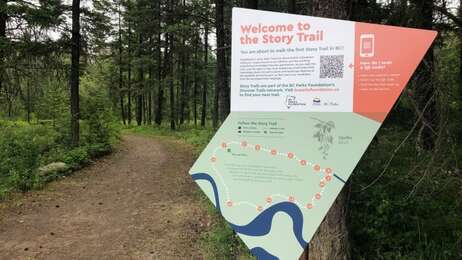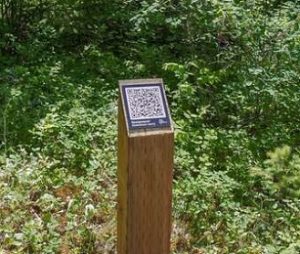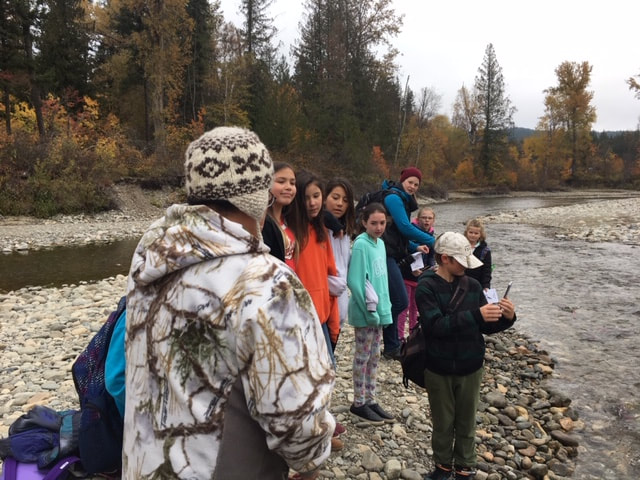Recommendation #1: Place Based Learning Using QR Codes and Student Voice
Place Based Learning and FPPL
Place based learning can be described as the process of using the local environment as a starting point to teach across a variety of curricular areas. It encourages hands-on, real-world, and engaging learning experiences. This approach helps students develop stronger ties to their community and enhances appreciation of the natural world (Sobel, 2004). Students are able to experience their local heritage, culture, and landscapes when they are able to leave the classroom and participate in learning activities in their community. The connection between place based learning and traditional aboriginal ways of knowing are clear. Place based learning emphasises community, the natural environment, experiential learning, and a sense of place. These are all key components that are consistently woven throughout the First People’s Principles of Learning.
Example: Story Trail in Tsútswecw Park
Tsútswecw Provincial Park (formerly Roderick Haig Brown Provincial Park) is located on both sides of the world famous Adams River between Shuswap Lake and Adams Lake in the interior of British Columbia. This is also the traditional territory of the Secwépemc people. It is home to one of the largest sockeye salmon runs in the world. Every four years, during the “dominant run”, people from all over the world converge on the park to observe this spectacle of nature. The park has a large trail system that allows visitors to observe various portions of the river and its many estuaries.

The Chase Secondary and Haldane Elementary Secwépemctsin language teacher Ivy Chelsea recently worked very hard with her students to create a “Story Trail” in the park. Students produced audio recordings with stories and information about the landscapes, plants, and important aspects of the local indigenous communities. They also included secwépemctsin language in their descriptions. Visitors are able to use their smartphones to scan the QR codes and listen to the descriptions as they travel along the trails and become immersed in the rich culture and history connected to the area.

Explore Story Trail in Tsútswecw Park and the interactive map within it for more information and to hear the student audio recordings that are connected to the QR codes on the story trail.
View the short video to the left for more detailed information about the story trail project.
First People’s Principles of Learning Evident in this Activity:
- Learning ultimately supports the well-being of the self, the family, the community, the land, the spirits, and the ancestors
- Learning is holistic, reflexive, reflective, experiential, and relational (focused on connectedness, on reciprocal relationships, and a sense of place)
- Learning recognizes the role of indigenous knowledge
- Learning is embedded in memory, history, and story
Possible Connections to Curricular Competencies and the BC Curriculum (Students will be able to):
- Use Social Studies inquiry processes and skills to – ask questions; gather, interpret, and analyze ideas; and communicate findings and decisions (Social Studies 7)
- Assess the significance of people, places, events, or developments at particular times and places (Social Studies 7)
- Recognize how language constructs personal, social, and cultural identity (ELA 7)
- Recognize and appreciate the role of story, narrative, and oral tradition in expressing First Peoples perspectives, values, beliefs, and points of view (ELA 7)
- Apply First Peoples perspectives and knowledge, other ways of knowing, and local knowledge as sources of information (Science 7)
- Express and reflect on a variety of experiences and perspectives of place (Science 7)
- Identify and use appropriate tools, technologies, and materials for production (ADST 7)
What can educators do?
Learning opportunities and environments are all around us. They are not limited to the inside of our schools and classrooms. Much can be discovered by venturing into our communities to explore landscapes, people, language and community on a first hand basis. Student learning will inevitably be enriched as they experience places and develop their own unique artifacts to demonstrate their learning. Using technology for audio or video recordings can be a powerful tool to examine learning in the moment. QR codes allow these moments to be observed by others and can bring pieces of the outside environment into our schools.

What do educators need?
- Devices for recording student audio or video
- Software to create QR codes: Flipgrid, QR Code Generator, QR Code Monkey
- Locations in the community for student exploration
- Students, staff, parents, and community members to engage with the QR codes and observe student learning experiences
- Language teaching resource – First Voices